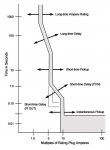It's sometimes easier to coordinate with other fuses or circuit breakers in the system when the line is sloped like that and not at a hard 90 degrees. Essentially what you're trying to accomplish when setting up breaker settings like your trip unit is to achieve breaker coordination in the system. For example, you don't want an entire facility to trip out because of an A/C unit going to ground. In an electrical power system, the most upstream circuit breakers have time delays programmed into them, so a scenario like I just mentioned doesn't happen. Having a time delay set up upstream means you're relying on the downstream circuit breakers to open very quickly, and isolate the fault as quickly as possible (in the case of our example, the circuit breaker feeding the A/C unit should trip first, and not the breaker feeding the entire MCC, for example).
However, the downside of achieving perfect system coordination is that the potential of an arc flash or system damage is increased. It's all a balance - arc flash potential vs system coordination.

